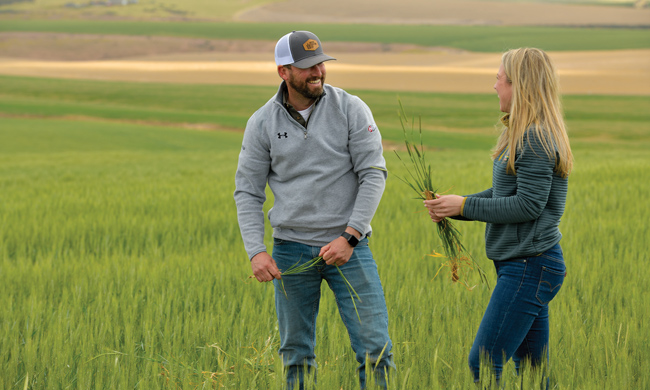What we’re seeing is a removing of cooling that’s revealing warming that’s already there. So the air pollution isn’t the cause of the warming. It’s just letting us see stuff that we’ve already done.Listen to the interview on The Conversation Weekly podcast. You can also read an article by Laura Wilcox and her colleague Bjørn H. Samset about their recent research on The Conversation. This episode of The Conversation Weekly was written and produced by Mend Mariwany, Gemma Ware and Katie Flood. Mixing by Michelle Macklem and theme music by Neeta Sarl. Newsclips in this episode from Voice of America, CBC, AP Archive, ABC (News) Australia, WFLA NBC Channel 8 and PBS. Listen to The Conversation Weekly via any of the apps listed above, download it directly via our RSS feed or find out how else to listen here. A transcript of this episode is available via the Apple Podcasts or Spotify apps.
The Earth
5 Sustainable Agriculture Practices for Long-Term Success
Implementing sustainable practices aimed at sequestering carbon, or carbon farming, can help farmers and ranchers increase their bottom line while managing environmental impact in numerous ways, including keeping the soil covered year-round, reducing or eliminating tillage and effectively managing range and pasture lands.
Last Updated on November 20, 2024 by Daily News Staff

Sustainable Practices
(Family Features) Implementing sustainable practices aimed at sequestering carbon, or carbon farming, can help farmers and ranchers increase their bottom line while managing environmental impact in numerous ways, including keeping the soil covered year-round, reducing or eliminating tillage, and managing range and pasture lands. Carbon farming practices help farmers and ranchers reap the proven benefits of a conservation approach. That, combined with a new revenue stream available via voluntary carbon programs, offers the potential for better outcomes.
Of the Earth’s land surface, 38% is used for agriculture. Capturing carbon in the soil is an affordable and scalable way to cut greenhouse gas emissions in the atmosphere while nurturing healthy, secure and sustainable food systems. Through soil carbon sequestration, farmers and ranchers can become leaders in limiting the effects of climate change while enriching the land’s livelihood.
Implementing practices that meet operational needs, and ultimately sequester carbon to generate carbon credits, allows ranchers and farmers to create additional income, lower future management costs and improve soil health, resulting in enhanced yields, cost savings and more resilient, healthy fields and pastures.
Working closely with farmers and ranchers across the United States, Agoro Carbon Alliance helps implement sustainable practices like these, which bolster natural soil fertility and can also generate carbon credits and new revenue streams.
- No-Till and Reduced-Till Farming: Reducing or eliminating tillage minimizes disruption to the soil and reduces carbon emissions. When soil is tilled, it releases carbon stored within the ground into the atmosphere. Moving an operation to reduced till or no-till practices not only offers benefits to soil quality but can also play a role in mitigating soil erosion, as well as reducing fuel and labor costs.
- Cover Crops: Cover crops improve soil health and help keep carbon “locked in” while preventing nutrient loss and erosion in fields. Developing an effective and profitable cover crop strategy is one way farmers partner with Agoro Carbon Alliance. Backed by a team of highly trained agronomists that collaborate with producers, their team of local agronomists work one-on-one with producers to build a cover crop strategy that best suits each unique operation and keeps soil thriving year-round.
- Interseeding: A related and valuable approach to soil protection and carbon sequestration is interseeding. This occurs when a new crop is planted as a cover or companion in a field where an existing crop has reached vegetative growth. Interseeding increases the number of plants in the soil, resulting in more roots, which promote more efficient biomass and carbon sequestration.
- Rotational Grazing and Grazing Management: Controlling livestock grazing patterns can be advantageous for animal health, as well as the soil and pasture quality. Moving animals from one pasture to another on a systematic basis provides greater control over the quality of the forage, allowing plants to deepen root systems, which enhances the soil’s biomass and supports more efficient carbon sequestration. Rotational grazing also prevents the soil from becoming excessively compacted by animal movement and allows ranchers to distribute natural manure fertilization more evenly.
- Nitrogen Management: Strategically managing how and when nitrogen fertilizer is applied can both increase crop efficiency and yield potential while reducing environmental impacts associated with nitrogen fertilizers. Judicious use of nitrogen-containing fertilizers can help optimize carbon storage, boost yield potential and improve forage.
Soil conservation practices can drive productivity and add a new revenue stream for farm and ranch operations, as well as generate carbon credits. Learn more about sustainable agriculture and carbon cropping at agorocarbonalliance.com.
SOURCE:
Agoro Carbon Alliance
Our Lifestyle section on STM Daily News is a hub of inspiration and practical information, offering a range of articles that touch on various aspects of daily life. From tips on family finances to guides for maintaining health and wellness, we strive to empower our readers with knowledge and resources to enhance their lifestyles. Whether you’re seeking outdoor activity ideas, fashion trends, or travel recommendations, our lifestyle section has got you covered. Visit us today at https://stmdailynews.com/category/lifestyle/ and embark on a journey of discovery and self-improvement.
Discover more from Daily News
Subscribe to get the latest posts sent to your email.
The Knowledge
What Is a Gustnado?
A gustnado may look like a tornado, but it’s a different weather phenomenon. Learn what a gustnado is, how it forms, and why it’s usually weaker.
Last Updated on December 18, 2025 by Daily News Staff
A gustnado east of Limon, Colorado. Image Credit: Jessica Kortekaas
Severe weather can produce dramatic sights—but not every spinning column of air is a tornado.
A [gustnado](chatgpt://generic-entity?number=0) is a brief, ground-level swirl of rotating air that forms along a thunderstorm’s gust front. Gustnadoes often appear suddenly, kicking up dust or debris, which can make them look more dangerous than they actually are.
Unlike tornadoes, gustnadoes do not connect to a storm’s rotating updraft. Because of this, they are usually weaker, short-lived, and difficult to detect on weather radar.
Gustnadoes typically last only seconds to a few minutes and are most commonly spotted in dry regions, where loose soil makes their rotation visible.
The takeaway: If it’s spinning near the ground ahead of a storm, it may look intense—but it’s not always a tornado.
Learn the differences between tornadoes, dust devils, and other rotating weather phenomena in our STM Daily News Knowledge Series.
Discover more from Daily News
Subscribe to get the latest posts sent to your email.
podcasts
How China cleaned up its air pollution – and what that meant for the climate
How China cleaned up its air pollution: Beijing’s air quality went from hazardous to good while Delhi and Lahore still struggle. Discover how China dramatically reduced pollution since 2013—and why cleaner air may have unintended consequences for global warming and climate change.
How China cleaned up its air pollution – and what that meant for the climate
Dive into “The Knowledge,” where curiosity meets clarity. This playlist, in collaboration with STMDailyNews.com, is designed for viewers who value historical accuracy and insightful learning. Our short videos, ranging from 30 seconds to a minute and a half, make complex subjects easy to grasp in no time. Covering everything from historical events to contemporary processes and entertainment, “The Knowledge” bridges the past with the present. In a world where information is abundant yet often misused, our series aims to guide you through the noise, preserving vital knowledge and truths that shape our lives today. Perfect for curious minds eager to discover the ‘why’ and ‘how’ of everything around us. Subscribe and join in as we explore the facts that matter. https://stmdailynews.com/the-knowledge/
Discover more from Daily News
Subscribe to get the latest posts sent to your email.
The Knowledge
Fern Stems Reveal How Evolutionary Constraints Create New Forms in Nature
Evolutionary Constraints: New research on fern vascular systems reveals how developmental constraints don’t just limit evolution—they generate new forms. Discover how leaf placement determines stem structure and what this means for understanding biodiversity and plant breeding.

Fern Stems Reveal How Evolutionary Constraints Create New Forms in Nature
Jacob S. Suissa, University of Tennessee There are few forms of the botanical world as readily identifiable as fern leaves. These often large, lacy fronds lend themselves nicely to watercolor paintings and tricep tattoos alike. Thoreau said it best: “Nature made ferns for pure leaves, to show what she could do in that line.” But ferns are not just for art and gardens. While fern leaves are the most iconic part of their body, these plants are whole organisms, with stems and roots that are often underground or creeping along the soil surface. With over 400 million years of evolutionary history, ferns can teach us a lot about how the diversity of planet Earth came to be. Specifically, examining their inner anatomy can reveal some of the intricacies of evolution.Sums of parts or an integrated whole?
When one structure cannot change without altering the other, researchers consider them constrained by each other. In biology, this linkage between traits is called a developmental constraint. It explains the limits of what possible forms organisms can take. For instance, why there aren’t square trees or mammals with wheels. However, constraint does not always limit form. In my recently published research, I examined the fern vascular system to highlight how changes in one part of the organism can lead to changes in another, which can generate new forms.
Fern vasculature and the process of evolution
Ferns are one of four lineages of land plants that have vascular tissues – specialized sets of tubes that move water and nutrients through their bodies. These tissues are composed of vascular bundles – clusters of cells that conduct water through the stem. How vascular bundles are arranged in fern stems varies substantially. Some have as many as three to eight or more vascular bundles scattered throughout their stem. Some are arranged symmetrically, while others such as the tobacco fern – Mickelia nicotianifolia – have bundles arranged in a whimsical, smiley-face pattern.
Simple observations and insights into evolution
I wondered how this variation in the number and arrangement of vascular bundles relates to leaf placement around the stem. So I quantified this variation in vascular patterning for 27 ferns representing roughly 30% of all fern species. I found a striking correlation between the number of rows of leaves and the number of vascular bundles within the stem. This relationship was almost 1-to-1 in some cases. For instance, if there were three rows of leaves along the stem, there were three vascular bundles in the stem. What’s more, how leaves were arranged around the stem determined the spatial arrangement of bundles. If the leaves were arranged spirally (on all sides of the stem), the vascular bundles were arranged in a radial pattern. If the leaves were shifted to the dorsal side of the stem, the smiley-face pattern emerged. Importantly, based on our understanding of plant development, there was a directionality here. Specifically, the placement of leaves determines the arrangement of bundles, not the other way around.
From parochial to existential
While this study on ferns and their vascular system may seem parochial, it speaks to the broader question of how variation – the fuel of evolution – arises, and how evolution can proceed. While not all parts of an organism are so tightly linked, considering the individual as a whole – or at least sets of parts as a unit – can help researchers better understand how, and if, observable patterns can evolve in isolation. This insight takes scientists one step closer to understanding the minutia of how evolution works to generate the immense biodiversity on Earth. Understanding these processes is also important for industry. In agricultural settings, plant and animal breeders attempt to increase one aspect of an organism without changing another. By taking a holistic approach and understanding which parts of an organism are developmentally or genetically linked and which are more quasi-independent, breeders may be able to more effectively create organisms with desired traits.
The science section of our news blog STM Daily News provides readers with captivating and up-to-date information on the latest scientific discoveries, breakthroughs, and innovations across various fields. We offer engaging and accessible content, ensuring that readers with different levels of scientific knowledge can stay informed. Whether it’s exploring advancements in medicine, astronomy, technology, or environmental sciences, our science section strives to shed light on the intriguing world of scientific exploration and its profound impact on our daily lives. From thought-provoking articles to informative interviews with experts in the field, STM Daily News Science offers a harmonious blend of factual reporting, analysis, and exploration, making it a go-to source for science enthusiasts and curious minds alike. https://stmdailynews.com/category/science/
Discover more from Daily News
Subscribe to get the latest posts sent to your email.

